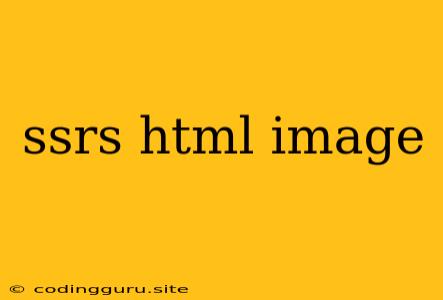Embedding Images in SSRS Reports Using HTML
SSRS (SQL Server Reporting Services) provides a powerful and versatile platform for creating dynamic and visually appealing reports. While SSRS offers a robust set of built-in features for rendering data, there are times when you might need to include external images within your report. This is where the power of HTML comes into play.
Why use HTML to embed images in SSRS?
SSRS offers a dedicated "Image" report item for displaying static images. However, this approach has its limitations. If you need to display dynamic images based on report data, handle complex image layouts, or simply prefer a more flexible approach, integrating HTML into your SSRS reports is a great solution.
How to embed HTML with images in SSRS
Here's a step-by-step guide on integrating HTML and images into your SSRS reports:
- Prepare Your Image: Ensure the image you want to embed is accessible from the server where your SSRS reports are deployed. This could be a local file path, a network share, or a URL pointing to the image.
- Create the HTML: Construct the HTML snippet that includes the image. You'll need to use the
<img>tag, specifying the appropriatesrcattribute to point to your image source:

- Integrate HTML into SSRS:
- In your SSRS report design, add a Textbox report item.
- In the Textbox properties, under "General", set "Markup Type" to HTML.
- Paste your HTML code containing the image into the Textbox.
Important Considerations:
- Image Resolution: Ensure your images are optimized for web display. High-resolution images can slow down report loading times.
- Accessibility: Always provide alternative text for your images using the
altattribute. This text will be displayed for users who cannot view images or use screen readers. - Security: If you're accessing images from external sources, ensure appropriate security measures are in place to prevent unauthorized access or data breaches.
Example:
Let's say you have a report that displays customer information. You want to include a logo image for each customer based on their company name. You can achieve this using HTML within your SSRS report:
-
Image Source: You have a folder on the server that stores customer logos. The image filenames correspond to the company names. For example, "Acme.jpg" for "Acme Corporation".
-
HTML Structure: Within the "Details" group of your report, add a Textbox and set its "Markup Type" to "HTML". You can dynamically generate the HTML using an expression:

This expression will dynamically construct the image path based on the company name retrieved from the report data.
Advanced Techniques:
- CSS Styling: Use CSS styles within the HTML to control image size, positioning, and other display attributes.
- Dynamic Image Size: Utilize HTML and JavaScript to dynamically resize images based on report layout or screen size.
- Conditional Image Display: Control which image is displayed based on specific criteria using conditional logic within your HTML.
Conclusion
By leveraging the power of HTML, you can overcome the limitations of the standard "Image" report item in SSRS. You can create dynamic, interactive, and visually appealing reports with ease, allowing you to present data in a more engaging and informative way.
